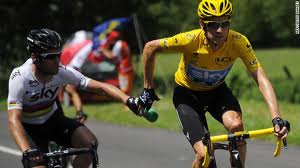Last year I remember reading this article at Velonation, where Taylor Phinney was being interviewed and he said that he never used finish bottles. I had no idea what he was talking about initially, so I spent a little time looking into it and it amazed me that some/many/most/all (you choose) of the Professional teams have doctors mix up special water bottles that contain caffeine, plus tramadol. They call these finish bottles. If you’ve never heard of tramadol, it is a centrally acting opioid analgesic used to treat moderate to moderately severe pain.
I didn’t feel that I had enough information to post something hear about it. But, Cyclingnews.com did an article a couple days ago about the problem and it stated “WADA has also confirmed that a ‘significant’ number of tests have shown traces of the drug.”
The article goes on to interview Prentice Steffen MD, the head physician at Garmin-Sharp. Prentice confirmed the Garmin’s team use of the drug, but they seem to have come to a consensus when to use it.
From Cyclingnews-
“We’ve had a lot of discussions about it with many of the riders on the team and Jonathan [Vaughters] and I. We arrived at what we think is a reasonable and sensible approach, which is that it’s not banned and it’s a drug like any other so it has approved usages, but all medication is to be used to its appropriate indications. So we’ve said that a hard day in the saddle is not an appropriate occasion for the use of tramadol. But if they have a painful condition and pain medication is appropriate, we think that then it could be reasonable. I don’t like it, I think we can get by without it.”
Asked if he believed that riders in the professional peloton were abusing the use of tramadol in order to boost their performances, Steffen gave an unwaveringly clear response.
“Absolutely. I know it’s a problem. It’s not a big performance enhancer but it could make the difference of a fraction of a per cent. It’s like nothing compared to EPO or blood doping but it’s more on the side of cortico-steroids. If blood doping is a ten then it’s a two, maybe.
“I can imagine it being used for training. Anything that makes an intense effort or suffering more tolerable is going to give you a training advantage.”
In Velonation article I referenced above, Taylor says, “There is widespread use of finish bottles, which are just bottles of crushed up caffeine pills and painkillers. That stuff can make you pretty loopy, and that is why I have never tried it. I don’t even want to try it as I feel it dangerous.” So he pretty much confirms that if he would like to “try” the finish bottle, it would be at he disposal. So that is two “American Teams” that use finish bottles.
I remember last year in the Tour, when Chris Froome took two bottles with less than 10km left. (It might have been 2 years ago with Wiggins, my memory is fussy.) For sure last year, Richie Porte took a bottle illegally and gave it to Froome. I never could understand how that could make a difference so close to the end of a race, but this whole finish bottle thing explains a lot.
It sort of reminds me of the 90’s, with ‘Pot Belge’. I think the ingredients fluctuated some, but the main ones were caffeine, amphetamines, cocaine and heroin. I remember reading a excerpt of a French rider that had been busted and he said that the first time he tried Pot Belge was in Laurent Jalebert’s garage at a team party. For some reason that seemed so much worse. It doesn’t seem like you should be using the drugs you use for athletic competition when you are just out on Friday or Saturday night partying.
But, I guess the difference is that tramadol isn’t banned by WADA. It is kind of a tricky thing to get your mind around. Instinctually, it just feels all wrong. Taking an opiate to race. Especially if you aren’t hurt and are just doing it to mask pain. But, where do you draw the line? Is ibuprofen different? Aspirin? I’m not sure. I would be sure if WADA banned the drug for use in competition, which I believe they should. But, most likely, there is just another non-banned drug that acts very similar to tramadol that would replace it instantly.
I guess it really isn’t such a big deal anyway, because of Prentice Steffen says above, it really doesn’t provide that much more than just taking cortico-steroids.
It sort of seems like a losing battle sometimes.






Painkillers in a team bottle. Racing by definition is painful. No pain, no gain. A very, very slippery slope. I hope Garmin leads the way on this issue.
Naw Mr Tilford in all honesty sir fk a finish bottle . . . .
If you are with a woman you arent going to go to the bedside table for a bottle of nasty day old ground up pills and stale water in the heat of action, would you?
geez I thought I was creative when I dissolved a BC powder in my bottles… no wonder I can’t get a pro contract…
Can someone ask the BMC soigneurs if finish bottles are used by the team?
I think that it was at this years tour that Froome took the late feed. He was actually penalized for it. I was wondering why Team Sky would risk a time penalty for a feed, but now I see why they might have.
http://www.cyclingnews.com/news/froome-penalised-20-seconds-for-illegal-feeding
chris-i think by Taylor’s public statements on the subject, he had been “offered” the use of finish bottles in the past, so the answer would have to be yes.
Now I understand Froome’s crazy high- cadence attacks in the TDF!
Here’s another example of how the team doctors are not stepping up to help end the doping mess. Tramadol is a very common pain drug and it is very cheap so it is easy to “see” why it is used. HOWEVER, while not technically against the rules it violates the spirit of competition and should be banned.
I have about given up hope that bicycle racing at any level will ever be “clean” and here’s another example of violating the spirit of sport. Oh well….
Herb
I´m strong, I win big pro bike races, I don´t need this crap! Give me a steak man!
Wow. Tramadol can cause dependency. “Soften the Fuck Up”, everybody!
Yes, yes, yes, Imsogood! Only in America do we have such athletes…..!!!
We know Taylor doesn’t like Tramadol in his finish bottle but what does he like in his finish bottle instead? Also, do they ever get the Tramadol and non-Tramadol finish bottles mixed up? In my day a finish bottle was a Coke.
Does it have dangerous side effects or pose long term health risks? If so then is should be banned.
I can thank the late Russ Okawa for handing up the best finish bottle I ever had. It basically consisted of the left-over remnants of 20 other bottles he collected (not recommended by the way) and topped off with a de-fizzed Coke. Who knows what I would have tested positive for after that race. it was disgusting but a Norba National win was worth the post-race vomiting.
Invite Och over for dinner, ply him with good wine, put a kitten in his lap and then proceed to give him give a nice, non-sexual foot rub.
You can start with a simple, “my virtual friends from the interweb have some running bets that I hoped you could finally settle….” 🙂
A new client who was hit (failure to yield turning left) last week came in with his hospital prescribed Tramadol for his clavicle fracture. I told him to tough out the pain now, so he can save the drugs for his “finishing bottle” when he’s back on the bike! Thank you, Steve, for providing this kind of in-depth cycling analysis that helps me better serve my clients!
Same as it ever was. Anyone else old enough to remember the tales told of Freddy Maertens? His finish bottle (Called “atom bottle” by Eddy B back-in-the-day with a formula – strong coffee, glucose and rum) was supposedly a 50/50 mix of water and champagne. And as his career wound down the percentage of the bubbly went up to pretty much 100%. WADA needs to set some sort of limit on this opiate, and perhaps take a close look at BAC as well in the post-race testing?
My finishing bottle is whatever coke or pepsi I can buy at a gas station…
I say, good for Taylor. He is one class act. I’m proud to have met him.
Likewise for his mom and dad,
The story is based on some facts (Tramadol has been found in a significant number of samples from the Pro peleton). To then point the finger at two TdF winners and not get a basic fact right is lazy, at best, and undermines the main thrust of a good argument. Any rider going hard all day will have experience bonking and would have mugged a granny for the merest sniff of some calories. If a top rider has to break the rules to get a gel when he has gone too close to the limit ask yourself: what would you do? You know you are not going to get away with it, you are on several cameras at any one time, and it is no different from any other professional foul in any other sport. Yes you do it. You may not be proud but you have not lost the race for want of calories. That is very different from the Finishing Bottle.
If, as this and several of the pro peleton are suggesting, Tramedol and a cocktail of other substances are being used in finishing bottles then what should happen? For me a decision from WADA on when and where a drug can be used and sanctions on riders, teams and above all the prescribing doctor (where are they in this little argument?) should be determined. This is not just for cycling though, other endurance sports will also be doing this.
The difference with cycling is that we are actively addressing and talking about it. Teams like Garmin should be actively encouraged to be open in what they use and why. Hiding any of this only leads in one direction and none of us want to go back there.
So if you are going to write about this please do yourself justice and check what you write. Then check it again. If you do this and you care what you write about, which you obviously do, then it all adds weight to the changes that have gone on. This is a bit of a rant, I know, but when you have the likes of Kathy Lemond tweeting an article, a lot of people are going to read it and hopefully take notice. I
f you are still reading sorry, but a bad day at the office so I had better go and top up on my endorphins and go and ride my bike.
Finish. Bottles. Containing tramadol and caffeine are prohibited under WADA code section Prohibited Methods. Prosecution requires evidence to show thru a balance of probability that the substance was taken with the intent to enhance performance rather than a justified medical treatment.